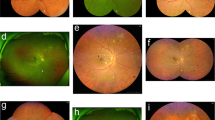Abstract
Red-free light allows better detection of vascular lesions as this wavelength is absorbed by hemoglobin; however, the current gold standard for the detection and grading of diabetic retinopathy remains 7-field color fundus photography. The goal of this study was to compare the ability of 7-field fundus photography using red-free light to detect retinopathy lesions with corresponding images captured using standard 7-field color photography. Non-stereoscopic standard 7-field 30° digital color fundus photography and 7-field 30° digital red-free fundus photography were performed in 200 eyes of 103 patients with various grades of diabetic retinopathy ranging from mild to moderate non-proliferative diabetic retinopathy to proliferative diabetic retinopathy. The color images (n = 1,400) were studied with corresponding red-free images (n = 1,400) by one retina consultant (PV) and two senior residents training in retina. The various retinal lesions [microaneurysms, hemorrhages, hard exudates, soft exudates, intra-retinal microvascular anomalies (IRMA), neovascularization of the retina elsewhere (NVE), and neovascularization of the disc (NVD)] detected by all three observers in each of the photographs were noted followed by determination of agreement scores using κ values (range 0−1). Kappa coefficient was categorized as poor (≤0), slight (0.01–0.20), fair (0.2 –0.40), moderate (0.41–0.60), substantial (0.61–0.80), and almost perfect (0.81–1). The number of lesions detected by red-free images alone was higher for all observers and all abnormalities except hard exudates. Detection of IRMA was especially higher for all observers with red-free images. Between image pairs, there was substantial agreement for detection of hard exudates (average κ = 0.62, range 0.60−0.65) and moderate agreement for detection of hemorrhages (average κ = 0.52, range 0.45−0.58), soft exudates (average κ = 0.51, range 0.42−0.61), NVE (average κ = 0.47, range 0.39−0.53), and NVD (average κ = 0.51, range 0.45−0.54). Fair agreement was noted for detection of microaneurysms (average κ = 0.29, range 0.20−0.39) and IRMA (average κ = 0.23, range 0.23−0.24). Inter-observer agreement with color images was substantial for hemorrhages (average κ = 0.72), soft exudates (average κ = 0.65), and NVD (average κ = 0.65); moderate for microaneurysms (average κ = 0.42), NVE (average κ = 0.44), and hard exudates (average κ = 0.59) and fair for IRMA (average κ = 0.21). Inter-observer agreement with red-free images was substantial for hard exudates (average κ = 0.63) and moderate for detection of hemorrhages (average κ = 0.56), SE (average κ = 0.60), IRMA (average κ = 0.50), NVE (average κ = 0.44), and NVD (average κ = 0.45). Digital red-free photography has a higher level of detection ability for all retinal lesions of diabetic retinopathy. More advanced grades of retinopathy are likely to be detected earlier with red-free imaging because of its better ability to detect IRMA, NVE, and NVD. Red-free monochromatic imaging of the retina is a more effective and less costly alternative for detection of vision-threatening diabetic retinopathy.
Similar content being viewed by others
References
King H, Aubert RE, Herman WH (1998) Global burden of diabetes, 1995–2025: prevalence, numerical estimates, and projections. Diabetes Care 21:1414–1431
Powers AC (2008) Diabetes mellitus. In: Fauci AS, Braunwald E, Kasper DL et al (eds) Harrison’s Online, 17th edn. http://www.accessmedicine.com/
Klein R, Klein BE, Moss SE, Davis MD, DeMets DL (1989) The Wisconsin epidemiologic study of diabetic retinopathy. IX. Four-year incidence and progression of diabetic retinopathy when age at diagnosis is less than 30 years. Arch Ophthalmol 107:237–243
Klein R, Klein BE, Moss SE, Davis MD, DeMets DL (1984) The Wisconsin epidemiologic study of diabetic retinopathy. III. Prevalence and risk of diabetic retinopathy when age at diagnosis is 30 years or more. Arch Ophthalmol 102:527–532
Early Treatment Diabetic Retinopathy Study Research Group (1991) Early photocoagulation for diabetic retinopathy. ETDRS report No. 9. Ophthalmology 98: 766–785
American Academy of Ophthalmology Retina Panel (2008) Preferred practice pattern guidelines: diabetic retinopathy. American Academy of Ophthalmology, San Francisco
Harding SP, Broadbent DM, Neoh C, White MC, Vora J (1995) Sensitivity and specificity of photography and direct ophthalmoscopy in screening for sight threatening eye disease: the Liverpool diabetic eye study. BMJ 311:1131–1135
Kalm H, Egertsen R, Blohme G (1988) Non-stereo fundus photography as a screening procedure for diabetic retinopathy among patients with type II diabetes compared with 60D enhanced slit-lamp examination. Acta Ophthalmol 67:546–553
Delory FC, Gragoudas ES, Fransisco R, Pruett RC (1977) Monochromatic ophthalmoscopy and fundus photography: the normal fundus. Arch Ophthalmol 95:861–868
Wendt VG, Summanen P, Hallnais K (2005) Detection of diabetic retinopathy: comparison between red-free digital images and color transparencies. Graefes Arch Clin Exp Ophthalmol 243:427–432
Olson JA, Strachan FM, Hipwell JH (2003) Comparative evaluation of digital imaging, retinal photography and optometrist examination in screening for diabetic retinopathy. Diabet Med 20(7):528–534
Hellstedt T, Vesti E, Immonen I (1996) Identification of individual microaneurysms: a comparison between fluorescein angiography and red-free and colour photographs. Graefes Arch Clin Exp Ophthalmol 234:S13–S17
ETDRS Research Group (1991) Grading diabetic retinopathy from stereoscopic color fundus photographs: an extension of the modified Airlie House classification (ETDRS report number 10). Ophthalmology 98:786–806
Landis JR, Koch GG (1977) The measurement of observer agreement for categorical data. Biometrics 33:159–174
Conflict of interest
None
Author information
Authors and Affiliations
Corresponding author
Rights and permissions
About this article
Cite this article
Venkatesh, P., Sharma, R., Vashist, N. et al. Detection of retinal lesions in diabetic retinopathy: comparative evaluation of 7-field digital color photography versus red-free photography. Int Ophthalmol 35, 635–640 (2015). https://doi.org/10.1007/s10792-012-9620-7
Received:
Accepted:
Published:
Issue Date:
DOI: https://doi.org/10.1007/s10792-012-9620-7




